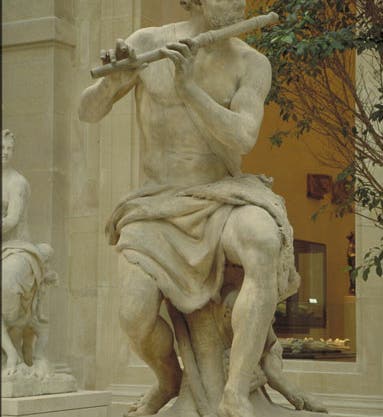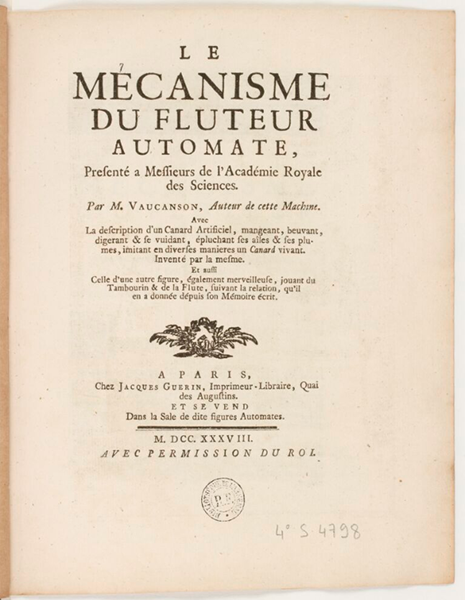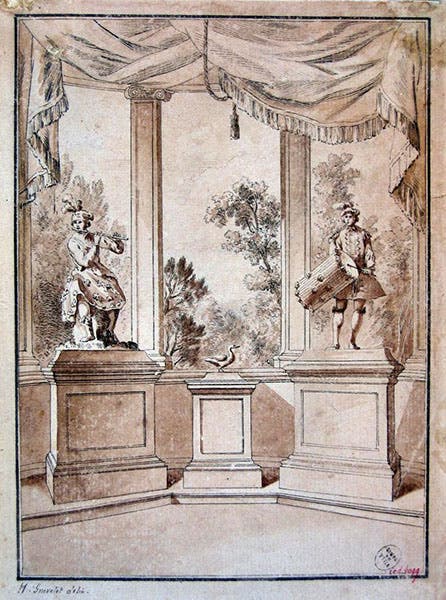Scientist of the Day - Jacques de Vaucanson
Jacques de Vaucanson, a French inventor, died Nov. 21, 1782, at age 73. Vaucanson was educated by Jesuits and for a while was a novice in the Minim order, before he received a dispensation from his vows, pleading a delicate digestive system. He must have built a number of mechanical marvels while a young man, if we are to explain the skill evident in his first public automaton, the Flute Player, which was unveiled in February of 1738 in the grand hall of the Hôtel de Longueville in Paris. Many craftsmen, over the previous several centuries, had built music boxes with mechanical figures attached, which appeared to be producing music, but were not. Vaucanson's flute player was modeled after a recent statue that stood nearby in the Tuileries Gardens, a marble figure of a flute-playing faun, sculpted by Antoine Coysevox, 1707-09 (and now in the Louvre, first image). But Vaucanson's Flute Player actually played the flute that he held in his wooden hands and leather-covered fingers, with the help of a pedestal filled with weights and gears that turned cams and actuated rods.
Vaucanson’s Flute Player had lips that changed shape and moved in and out, and a tongue that regulated the airflow, and three sets of bellows that provided different strength airstreams. This was not only an automaton, but an android, perhaps the first android – a mechanical human that played the flute better than most real humans. As you might imagine, it was quite the attraction when it was opened to the public, and many onlookers were willing to part with a large chunk of their weekly paycheck to see the Flute Player run through its repertoire of a dozen songs. In our second image, the Flute Player is the automaton on the right. The entire French Academy of Sciences came to visit, and Vaucanson wrote them an account of how it worked, which he then published as Le Mécanisme du fluteur automate, présenté ą Messieurs de l'Académie royale des sciences (1738, third image).
Later that same year, Vaucanson added two more automata to the display in the Hôtel. One was a fife-and-drum player. This automaton was difficult for Vaucason to construct, for, unlike the flute, a fife has only a few holes and relies on changing lip pressure and overtones to produce a full scale of notes, which apparently taxed Vaucanson's ingenuity. But we won't linger on the fife-player, for we must get to Vaucanson's masterpiece, which stood between the two musicians, but was not in the shadow of either. This was Le Canard Digérateur, the Digesting Duck, as it was often called. The duck, like the flute player, was life-size (which is to say, duck-size, and not very big at all), and stood on a pedestal that concealed a mechanical drum that drove the duck's various working parts. The duck could move its head, flap its wings, drink water, eat corn and grain, and best of all, after an appropriate interval, it would eject a pellet of duck poop from its nether parts, giving rise to its other name, the Defecating Duck. Vaucauson claimed that the Defecating Duck was actually processing its food intake to produce the poop pellets, but later investigation showed that the ingested food went into one internal cavity and the defecated pellet came from a separate container of green-dyed bread crumbs that were compressed by the duck's metallic sphincter.
Vaucauson soon tired of constructing and displaying automata, and in 1741 he got a real job, appointed by Louis XV's minister as inspector of silk manufacture for all France. He proceeded to try to automate the French silk-making industry, to the great displeasure of all the silk-workers, who rioted in response. His automata survived for at least a half-century, but the two human-like figures were taken apart and badly stored and eventually lost or burned. The duck seems to have survived until the end of the 19th century – there exist some mysterious photographs that seem to show its bedraggled remains above the driving drum. A drawing of its innards was published in Scientific American on Jan. 21, 1899, but it appears to be a visual reconstruction rather than a real drawing, and no one thinks it was based on Vaucanson's actual duck (fifth image).
Vaucanson is often regarded as the first true automaton maker, since preceding mechanical devices had most of their working parts under the floor, while Vaucanson's automata had built-in parts. Except for the drive train, all of the Flute Player's and the Defecating Duck's operating parts were part of the figure. The writing automaton of Henri Maillardet, which we featured here several weeks ago (see our post on Maillardet), was the direct heir of Vaucanson’s mechanical marvels of 1738-39.
We do not own a copy of Vaucanson's Le Mécanisme du fluteur automate, so I used the copy in the Bibliothèque nationale de France, which they have made available online. Our image of the frontispiece (second image) comes from that copy. Surprisingly, the original pen-and-wash drawing for the frontispiece, by Hubert-Francois Gravelot, survives, in the Musée Carnavalet in Paris (fourth image).
There exists only one portrait of Vaucanson, a miniature pastel by Joseph Boze, painted posthumously in 1784. The versions of it on Wikipedia and other online sources are not pleasant to look at, retouched and recolored The only decent reproduction I could find online is from a dictionary of pastelists, and it is small, but it seems far preferable to me (sixth image).
Two books that I recommend on Vaucanson and the history of automata are: Edison’s Eve: A Magical History of the Quest for Mechanical Life, by Gaby Wood (2002) and The Restless Clock: A History of the Centuries-Long Argument over What Makes Living Things Tick, by Jessica Riskin (2016).
William B. Ashworth, Jr., Consultant for the History of Science, Linda Hall Library and Associate Professor emeritus, Department of History, University of Missouri-Kansas City. Comments or corrections are welcome; please direct to ashworthw@umkc.edu.












